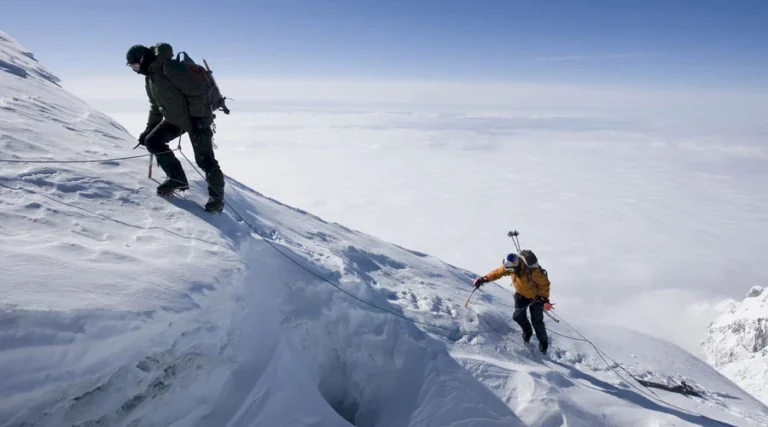Mount St. Elias, a monumental peak towering at 18,008 feet, straddles the border between Alaska and the Yukon, Canada, renowned for its challenging terrain and unpredictable weather. Situated within the Wrangell-St. Elias National Park and Preserve, the mountain holds significant cultural and spiritual importance for the Tlingit people, who consider it a sacred site known as Was’eitushaa or Yasʼéitʼaa Shaa.
First sighted by European explorers in 1741 during Vitus Bering’s expedition, Mount St. Elias remained unnamed until the 18th century. The first successful ascent was achieved in 1897 by Luigi Amedeo di Savoia-Aosta, Duke of Abruzzi, after multiple attempts. Since then, the mountain has been a formidable challenge for climbers, noted for its immense vertical relief and treacherous northwest ridge, which features steep rock and ice faces.
The mountain’s ascent demands meticulous planning, with climbers needing to navigate through broken glaciers, isothermic slush, and steep rock faces amidst frequent storms originating from the North Pacific. The weather is notorious for its unpredictability, posing substantial risks to expeditions, as highlighted by tragic incidents such as the 2002 ski descent attempt that claimed lives due to adverse conditions.
Cultural significance intertwines with Mount St. Elias’ physical challenges, as it serves as a spiritual beacon for the Tlingit people, guiding their migrations and weather predictions. Legend ties Mount St. Elias to Mount Fairweather, with both mountains believed to have once stood together before a dispute separated them, creating the Tsalx̱aanYátxʼi mountains in between. If you climb mountain in Nepal like Everest Expedition, Lobuche Peak, Island Peak, Manaslu, Ama Dablam, Lhotse then you can explore sherpa culture.
These feats underscore the mountain’s allure and the enduring challenges it presents to modern adventurers.Mount St. Elias remains a testament to nature’s grandeur and a pinnacle of mountaineering achievement, demanding unwavering determination and respect from those who dare to challenge its slopes. Each expedition contributes to the mountain’s rich history, adding layers to its lore and inspiring future generations to push the boundaries of human endeavor amidst the breathtaking Alaskan wilderness.
FAQs
- Who is the first person to reach the summit of St. Elias?
Mount St. Elias was first successfully ascended on July 31, 1897, by an Italian team led by the renowned Prince Luigi Amedeo, Duke of the Abruzzi. Prince Luigi Amedeo is also known for his exploration of the standard route on K2 in 1909.
- Is climbing Mount St. Elias possible?
Yes, you can climb Mount St. Elias, but it is a challenging endeavor. The mountain is typically accessed by bush planes, as most areas within the National Park are remote. Alternatively, climbers can embark on extensive hikes that span several miles and days, supported by air-dropped supplies of food and gear. Mount St. Elias is notable for being the highest peak so close to the ocean and features a significant vertical rise. - Where are the St. Elias Mountains located?
The St. Elias Mountains are a segment of the Pacific Coast Ranges located in northwestern North America. These mountains stretch southeastward for about 250 miles (400 km) from the Wrangell Mountains to Cross Sound, straddling the border between Yukon Territory in Canada and Alaska in the United States.

